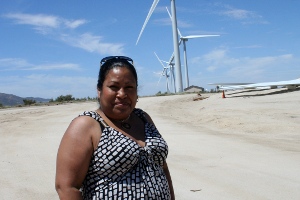STANDEN: The casino changed everything for the Campo Kumeyaay Nation, a small tribe of 329 people living in the desert mountains 60 miles east of San Diego. It bought a fire department, educational programs, jobs. But one modest casino-- especially in a slow economy-- isn't enough to sustain this community, where unemployment is almost 50 percent. LaChappa-- who serves as tribal chairwoman-- and others here have set their sights on a very different kind of project-- one that sets the Campo apart from any other tribe in the country.
[Wind turbine sound]
STANDEN: Here, along a rocky spine of the Laguna Mountains is the only utility-scale wind farm on tribal land in the country, built in 2005. There are two dozen turbines, each 4 stories tall, supplying energy to 35,000 homes in San Diego County. Their huge blades sweep the sky with the steady whoosh of a heartbeat.
This project-- called Kumeyaay 1-- is an enormous source of pride for the Campo people, in part because it makes use of a resource that until recently, didn't seem to offer a lot of options.
LACHAPPA: Look where we're located. We're out here in the middle of nowhere. It makes it difficult for anybody who wants to be able to do more for their family, or send their kids to college.
STANDEN: But income from this wind farm is limited... because the Campo don't own this project. Instead, they lease the land to a private company. The Campo are in negotiations to build a second wind project, three times the size of this one. This time, they plan to go in as co-owners, partnering with the Chicago-based private energy firm Invenergy and San Diego Gas and Electric. Ownership is a tough deal to strike -- one that's eluded other Indian tribes.
MIKE CONNOLLY: This has killed a lot of deals on Indian country.
STANDEN: Mike Connolly-- solidly built, with wire frame glasses and a gray ponytail-- is a former Campo tribal council member. He runs a consultancy firm that helps tribes get involved with renewable energy.
CONNOLLY Because the tribes want to have ownership. But when they do the numbers, the see that ownership is just not economically viable. So they end up not doing it, rather than doing it.
STANDEN: The primary problem, he says, has to do with the special legal status that tribes occupy: Tribes are sovereign nations, which means they can't take advantage of federal tax credits for renewable energy. And those can cut the price of a large wind project in half. Connolly says the lack of credits, of capital, combined with all the red tape surrounding tribal development threatens to leave American Indians out of the green economy. And that, he says, would be a terrible shame.
CONNOLLY: Especially when you think of the fact that Indian reservations are some of the poorest places in the country. I mean, there's this debate over double digit unemployment, we have reservations that have gone 4 or 5 decades of unemployment that's over 60 percent. And here you have an opportunity to build economies in Indian countries and to create a base that that's sustainable type of development that can go on and on.
STANDEN: On to places like the Morongo reservation, west of Palm Springs, where a grassy hillside rises behind the administration building. DeAnna Meetze would like to see this plot of land covered in solar panels, but she's been frustrated by some of the same tax hurdles the Campo face. Meetze says the history of tribes in this country has left other, subtler obstacles, too.
DEANNA MEETZE: With tribes inherently, there's a level of distrust among anyone who comes from the outside in. And you have to make sure you're dealing with someone of integrity, and that they're not there to take advantage of you.
STANDEN: Those obstacles will subside over time, she says, especially if the federal government helps level the playing field. That process has begun.
PRESIDENT OBAMA: Too often, you face unique hurdles to developing these renewable resources...
STANDEN: President Obama, speaking before the Tribal Nations Conference last November.
PRESIDENT OBAMA: We're securing tribal access to financing and thanks to the recovery act (FADE UNDER) for energy development...
STANDEN: Over the last two years, the pot of federal aid for Indian energy development has doubled to about $7 million a year. Tribes are also eligible for stimulus grants. And a new federal bill called the Indian Energy Promotion and Parity Act, would take the biggest step: making tribes eligible for the tax credits. The question is whether that bill will suffer the same fate as other energy legislation... so far, stalled out in Congress. For QUEST, I'm Amy Standen, KQED News.
 Over the last few weeks, we've been following California's push to produce a third of its electricity from renewable sources by 2020. It's estimated that more than ten percent of the potential for clean energy in the US sits on land owned by Indian tribes. Some of these tribes are wondering whether green energy projects might be the casinos of the 21st century. But as Amy Standen reports the idea faces some tough obstacles.
Over the last few weeks, we've been following California's push to produce a third of its electricity from renewable sources by 2020. It's estimated that more than ten percent of the potential for clean energy in the US sits on land owned by Indian tribes. Some of these tribes are wondering whether green energy projects might be the casinos of the 21st century. But as Amy Standen reports the idea faces some tough obstacles.